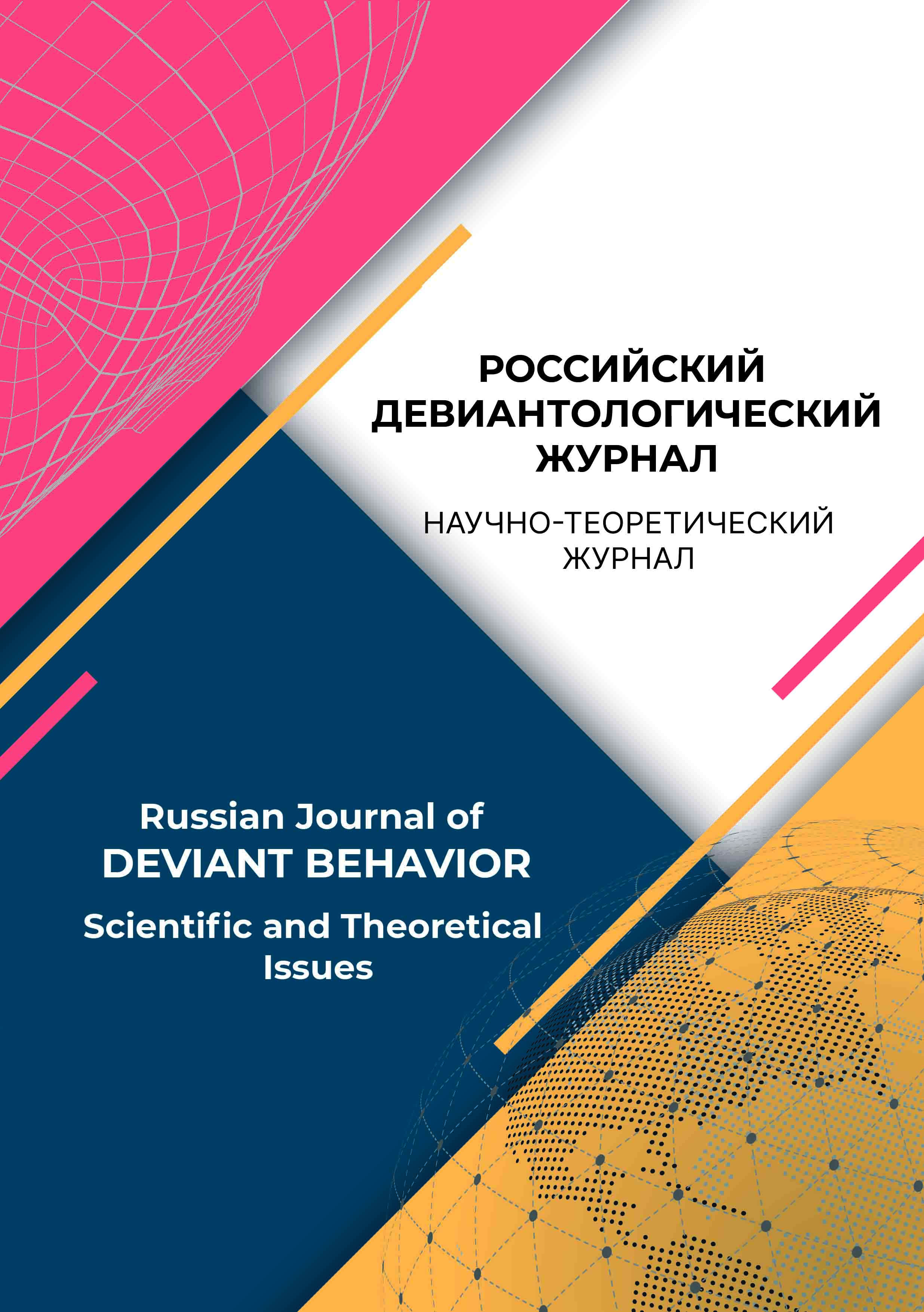Russian Federation
Russian Federation
UDC 316.624
The relevance of the research lies in the high social significance of research in the field of revealing mechanisms of destructive behavior formation in adolescence. The study of depth-psychological sphere of personality makes it possible to identify unconscious tendencies reflecting tendencies to destructive behavior, as well as to predict the risks of such manifestations in human behavior. Purpose of the research is the study and presentation of destructive and selfdestructive tendencies in the in-depth psychological sphere of young people living in urban and rural areas. Theoretical research methods are the comparative-analytical method as well as the inductive and deductive methods. Empirical research methods: methods of directed conversation, observation, as well as psychodiagnostic method (method of experimental diagnostics of motives «Szondi-Test»). Statistical processing of the data is carried out both manually and with the help of the software package «Statistica». The analysis of empirically received data indicates that the in-depth psychological sphere and its separate areas reflect the natural course of the crisis period of personal and social development for adolescence. Five conditional personality types of young people are identified: «Normally socialized», «Aggressive», «Destructive and self-destructive», «Passive and dependent», «Regressive and addictive». In analyzing it was found that the probability of destructive and selfdestructive tendencies in rural youth is higher than in urban youth. From the scientific point of view, the research confirms and completes the existing scientific information about the processes and regularities of personality development in adolescence. Scientific novelty of the research is given by the revealed and described in-depth psychological processes and peculiarities of personal and age development of young people.
addictions, deviations, destructions, fate-analysis, adolescence
1. Azarova, E. A. (2021). Psihologiya i pedagogika deviantnogo povedeniya: monografiya. Moskow: Obshchestvo s ogranichennoj otvetstvennost’yu “Kredo”. EDN ROUMLA.
2. Arpent’eva, M. R. (2017). Problemy bezopasnosti v Internete: cifrovaya besprizornost’ kak prichina cifrovoj zavisimosti i cifrovoj prestupnosti. Vestnik Prikamskogo social’nogo instituta, 3 (78), 99-110. EDN ZUEEZV.
3. Boyarshinova, I. M. (2015). Problemy reabilitacii narkozavisimoj molodezhi v usloviyah prigranichnogo regiona Orenburgskoj oblasti. Nauchnyj al’manah, 9 (11), 1360-1368. https://doi.org/10.17117/na.2015.09.1360
4. Druzhilov, S. A. (2017). Professional’no-destruktivnaya deyatel’nost’ kak proyavlenie professional’noj marginalizacii i deprofessionalizacii. Vestnik Moskovskogo universiteta. Seriya 14: Psihologiya, 2, 45-63. https://doi.org/10.11621/ vsp.2017.02.45
5. Egorov, A. Yu., Grechanyj, S. V. (2019). Sovremennye podhody k terapii i korrekcii internet-addikcii. Zhurnal nevrologii i psihiatrii im. S. S. Korsakova, 119 (6), 152-159. https://doi.org/10.17116/jnevro2019119061152
6. Zvereva, Z. F., Miroshnik, E. V. (2019). Opyt optimizacii funkcional’nogo sostoyaniya cheloveka muzykal’nymi sredstvami. Novoe v psihologo-pedagogicheskih issledovaniyah, 2 (54), 49-63. EDN UJKNSE.
7. Zondi, L. (2017). Patologiya pobuzhdenij. Chast’ A. Dialekticheskoe uchenie o pobuzhdeniyah i dialekticheskie metody testovogo analiza; Chast’ B. Elementy tochnoj psihiatrii pobuzhdenij (per. s nemeckogo i redakciya Vladimira Dzhosa). Moskow.
8. Katkova, A. S., Vachkov, I. V. (2020). Psihologicheskie determinanty vozniknoveniya vnutrilichnostnyh protivorechij studentov. Klinicheskaya i special’naya psihologiya, 9 (2), 246-265. https://doi.org/10.17759/cpse.2020090213.
9. Kovaleva, N. L. (2020). Primenenie proektivnyh testov dlya vyyavleniya i korrekcii agressivnogo povedeniya podrostkov v usloviyah detskogo doma. Chelovek i obrazovanie, 2 (63), 66-71. https://doi.org/10.54884/S181570410020781-4
10. Kruglova, E. A., Popel’, N. V. (2020). Sistemnyj podhod k issledovaniyu professional’nyh destrukcij lichnosti pedagogov. Sistemnaya psihologiya i sociologiya, 4 (36), 34-47. https://doi.org/10.25688/2223-6872.2020.36.4.3
11. Miroshnik, E. V., Minkin, V. A. (2019). Polieffektornyj metod diagnostiki profilya pobuzhdenij i potrebnostej psycomfort dlya ocenki effektivnosti individual’nogo stilya deyatel’nosti sotrudnikov. Sovremennaya psihofiziologiya. Tekhnologiya vibroizobrazheniya, 1 (2) 39-45. https://doi.org/10.25696/ELSYS.VC2.RU.5
12. Rudenkin, D. V., Vorob’eva, I. V., Kruzhkova, O. V., Krivoshchekova, M. S. (2018). Molodezhnyj vandalizm v srede megapolisa: granicy normy i deviacii. Obrazovanie i nauka, 20 (2), 125-146. https://doi.org/10.17853/1994-5639-2018-2-125-146
13. Pechenkova, E. A., Rogov, A. V., Samojlenko, A. B. (2020). Psihologicheskaya tekhnologiya preduprezhdeniya destruktivnyh koping-strategij u rukovoditelej organov vnutrennih del Rossijskoj Federacii. Prikladnaya psihologiya i pedagogika, 5 (3), 39-53. https://doi.org/10.12737/2500-0543-2020-96-110
14. Rahimkulova, A. S. (2020). Posledstviya riskovannogo povedeniya dlya fizicheskogo i psihicheskogo zdorov’ya podrostkov. Deviantologiya, 4 (1(6)), 3-15. https://doi.org/10.32878/devi.20-4-01(6)-3-15
15. Rozanova, A. A., Rozanov, F. I. (2020). Teoretiko-metodologicheskie osnovaniya primeneniya ekonomicheskogo issledovaniya motivacionnoj i povedencheskoj sfery v psihologicheskih teoriyah. Problemy social’no-ekonomicheskogo razvitiya Sibiri, 3 (41), 40-46. https://doi.org/10.18324/2224-1833-2020-3-40-46
16. Smirnov, A. V. (2010). Glubinno-psihologicheskie mekhanizmy predraspolozhennosti k addiktivnomu povedeniyu v strukture integral’noj individual’nosti. Vestnik Sankt-Peterburgskogo universiteta. Seriya 12. Psihologiya. Sociologiya. Pedagogika, 3. 214-223. EDN: https://elibrary.ru/NBPSVL.
17. Smirnov, A. V. (2014). Polovye osobennosti proyavlenij “addiktivnogo”, “pogranichnogo” i “neaddiktivnogo” tipov individual’nosti na glubinno-psihologicheskom urovne integral’noj individual’nosti. Evropejskij zhurnal social’nyh nauk, 6-3 (45), 329-337. EDN TJLDJD.
18. Soldatova, G. U., Shlyapnikov, V. N., Zhurina, M. A. (2015). Evolyuciya onlajn-riskov: itogi pyatiletnej raboty linii pomoshchi «Deti onlajn». Konsul’tativnaya psihologiya i psihoterapiya, 3 (87), 50-66. https://doi.org/10.17759/ cpp.2015230304
19. Trush, V. M., Gomonov, N. D. (2018). Kriminogennaya zarazhennost’ lichnosti prestupnika s pozicii sud’boanaliza L. Szondi. Yuridicheskie issledovaniya, 1, 1-30. EDN YOEFSI.
20. Fetiskin, N. P., Mironova, T. I. (2017). Mozaichnost’ lichnostnoj napravlennosti v genezise molodezhnyh deviantnyh novoobrazovanij. Sistemnaya psihologiya i sociologiya, 4 (24), 28-41. EDN YLBXEM.
21. Husainova, S. V., Hakimzyanov, R. N. (2019). Issledovanie psihologicheskih osobennostej lichnosti sklonnoj k deviantnomu povedeniyu. Kazanskij pedagogicheskij zhurnal, 6 (137), 195-201. EDN XYBMVZ.
22. Bezliudnyi, O., Kravchenko, O., Maksymchuk, B., Mishchenko, M., & Maksymchuk, I. (2019). Psycho-correction of burnout syndrome in sports educators. Journal of Physical Education and Sport, 19 (3), 1585-1590. https://doi. org/10.7752/jpes.2019.03230
23. Darius, S., Boeckelmann, I., Tymbota, M. O., Zavgorodnii, I. V., Zavgorodnia, N. I., & Kapustnik, W. A. (2017). Socio-psychological aspects of forming emotional burnout among high school teachers. New Armenian Medical Journal, 11. (2), 63-71. EDN XNXMQJ.
24. Curry, L. A., & Youngblade, L. M. (2006). Negative affect, risk perception, and adolescent risk behavior. Journal of Applied Developmental Psychology, 27 (5), 468-485. https://doi.org/10.1016/j.appdev.2006.06.001
25. García, B. H., Vázquez, A. L., Moses, J. O., Cromer, K. D., Morrow, A. S., & Villodas, M. T. (2021). Risk for substance use among adolescents at-risk for childhood victimization: The moderating role of ADHD. Child Abuse and Neglect, 114, 104977. https://doi.org/10.1016/j.chiabu.2021.104977
26. Ghazal, P. (2019). Rising trend of substance abuse in Pakistan: a study of sociodemographic profiles of patients admitted to rehabilitation centres. Public Health, 167, 34-37. https://doi.org/10.1016/j.puhe.2018.10.020
27. Hussein, Z., Griffiths, M. D., & Baguley, T. (2012). Online gaming addiction: classification, prediction and associated risk factors. Addiction Research & Theory, 20 (5), 359-371. https://doi.org/10.3109/16066359.2011.640442
28. Menon, S. V., Thakur, H., Shorey, R. C., & Cohen, J. R. (2019). Predicting Adolescent Substance Use in a Child Welfare Sample: A Multi-Indicator Algorithm. Assessment, 28 (4). 1207-1218. https://doi.org/10.1177/107319111988096
29. Miller T. W., Bilyeu J., Veltkamp L. J., Clayton, R., Welsh, R., & Elzie, N. (2001). Intimacy in addicted couples: clinical issues and case studies. Journal of Couples Therapy, 10 (3-4), 51-62. https://doi.org/10.1300/J036v10n03_06
30. Minkin, V. A., & Nikolaenko, N. N. (2008). Application of Vibraimage Technology and System for Analysis of Motor Activity and Study of Functional State of the Human Body. Biomedical Engineering, 42 (4), 196-200. https://doi.org/10.1007/s10527-008-9045-9M
31. Moradi, P., Lavasani, F. F., & Dejman, M. (2019). Adolescent substance abuse and family environment: A qualitative study. International Journal of High Risk Behaviors and Addiction, 8 (2), e83781. https://doi.org/10.5812/ijhrba.83781
32. Morales, A. M., Jones, S. A., Kliamovich, D., Harman, G., & Nagel, B. J. (2020). Identifying Early Risk Factors for Addiction Later in Life: a Review of Prospective Longitudinal Studies. Current Addiction Reports, 7 (1), 89-98. https://doi.org/10.1007/s40429-019-00282-y
33. Tabachnikov, S., Osukhovskaya, O., Vasylyeva, G., Kharchenko, E., Salden, V., & Chepunna, A. (2020). Psychoemotional Synergy Registerof Non-chemical Addiction and Tobacco Smoking in Young People. Psychiatry, psychotherapy and clinical psychology, 11 (3), 578-582. https://doi.org/10.34883/PI.2020.11.3.014
34. Schneider, J. P., & Irons, R. R. (2001). Assessment and treatment of addictive sexual disorders: Relevance for chemical dependency relapse. Substance Use & Misuse, 36 (13), 1795-1820. https://doi.org/10.1081/ja-100108428
35. Sotoudeh, H. G., Nazari, M. A., & Mirhashemi, M. (2021). Social-cognitive educational protocol for parents with adolescents at risk of substance use: Impact on adolescents’ life skill. Iranian Journal of Psychiatry, 16 (3), 295-304. https://doi.org/10.18502/ijps.v16i3.6255














